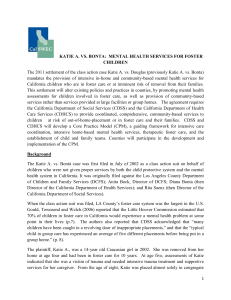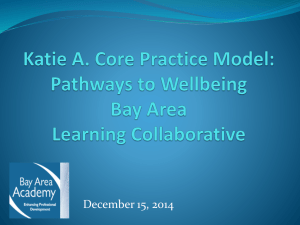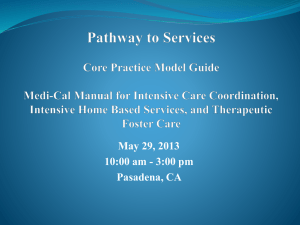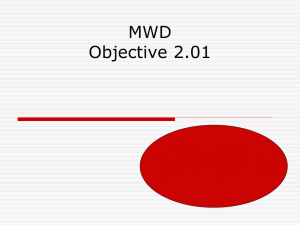Pathways to Mental Health Services
advertisement
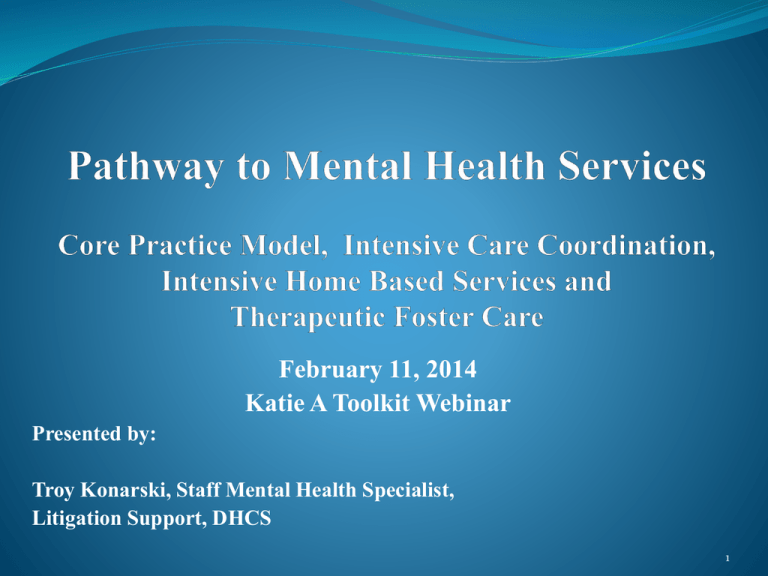
February 11, 2014 Katie A Toolkit Webinar Presented by: Troy Konarski, Staff Mental Health Specialist, Litigation Support, DHCS 1 Overview & Purpose Review the Information and Guidance Set Forth in the Core Practice Model & Medi-Cal Manual Updates on Implementation Obtain Feedback on Technical Assistance and Local Implementation Needs 2 Katie A. et al v. Bonta Settlement In July 2002, a complaint was filed to obtain Wraparound and therapeutic foster care services for children in or at risk of placement in foster care or group homes. In December 2011, the final settlement was approved. The Core Practice Model Guide and the Medi-Cal Manual were developed as a part of the settlement agreement. 3 Who is Katie A? Katie A. was a 14-years old girl at the time of the 2002 settlement. At 4 years old she was removed from her home and placed in foster care, where she remained for 10 years. Early assessments indicated she had a history of trauma and that intensive trauma treatment and supportive services for her caregiver would be the best approach to transitioning her home with her caregiver. Katie at age 8 was placed almost solely in congregate care facilities even though she responded best to one-on-one attention, and had difficulty with peer relations. She was moved through 37 different placements, including: 4 group homes, 19 different stays at psychiatric hospitals, a 2 year stay at Metropolitan State Hospital, and 7 stays at MacLaren Children’s Center. Early assessment indicated the services she and her family needed. She did not receive trauma treatment or other individualized outpatient mental health services. Weblink:http://www.docstoc.com/docs/140657047/Overview-of-Katie-A---CSU_-Chico 4 Katie A Class and Subclass Members Who are the members of the Katie A. Class and Subclass? What Guidance is Provided on Member Eligibility Consideration? 5 Katie A. Class Members Children and youth who are or at imminent risk of placement in foster care Have a mental illness or condition that has been documented, or if assessed would have a diagnosis with a mental illness or condition Who need individualized MH services Katie A identified a Class of children who must be provided services set forth and guided by the CPM 6 Katie A. Subclass Members Katie A Subclass are an identified subset of the Katie A Class who must also be provided a set of intensive services in addition to the services set forth and guided by the CPM Are full-scope Medi-Cal (Title XIX) eligible; Have an open child welfare services case (See definition in Appendix A, Glossary of the Medi-Cal Manual); and Meet the medical necessity criteria for Specialty Mental Health Services (SMHS) as set forth in CCR Title 9 Section 1830.205 or Section 1830.210. 7 Eligibility Considerations For Subclass In addition to the above criteria, the child and youth are currently in or being considered for: Wraparound Therapeutic foster care Specialized care rate due to behavioral health needs or other intensive EPSDT services Including but not limited to: Therapeutic Behavioral Services (TBS) Crisis stabilization/intervention (see definitions listed in the Medi-Cal Manual glossary) 8 Core Practice Model The Core Practice Model Guide (CPM) describes a significant shift in the way that individual service providers and systems are expected to address the needs of children/youth and families in the child welfare system, and additionally, it is intended as a blueprint for wider practice change and systems reform. CPM should be relied on for further guidance on the expectations of the model, the required elements for fidelity practice to the model and approaches to implementation. 9 Core Practice Model Guide Values and Principles Teaming Successful Elements Child and Family Teams Models Practice Components 10 CPM: Service Delivery Components Engagement Transition Monitoring and Implementation Assessment Service Planning and Implementation 11 CPM Child and Family Team The Child and Family Team (CFT )is a team that shares a vision with the family and is working to advance that vision, while a team meeting is how the members communicate. No single individual, agency or service provider works independently. Working as part of a team involves a different way of decision-making. 12 Medi-Cal Manual Guided by the Principles and values of the Core Practice Model (CPM) Provide mental health plans (MHPs) and Medi-Cal providers with information regarding the provision of three specialty mental health services for those children/youth who are members of a class of children covered by a Settlement Agreement in a lawsuit Katie A v. Bonita. Katie A Class and Subclass Members Clarifies and provides guidance on the coverage and documentation requirements under Medi-Cal of Intensive Care Coordination (ICC), Intensive Home Based Service (IHBS) and Therapeutic Foster Care (TFC) Additionally, serves as a supplement to other federal and state documents related to the delivery of specialty mental health services in the State of California 13 Intensive Care Coordination (ICC) Intensive Home Based Services (IHBS) Definitions of ICC and IHBS services Descriptions of service settings provided in the documentation manual Review of claiming and reimbursement guidance Overview of service components, activities, and review examples Assessing Service Planning and Implementation Monitoring and Adapting Transition 14 Intensive Care Coordination (ICC) The difference between ICC and the more traditional TCM service functions is that ICC must be used to facilitate implementation of the cross-system/multi-agency collaborative services approach described in the CPM for the Katie A. Subclass. 15 ICC Coordinator ICC coordinator is responsible for working within the CFT to ensure that plans from any of the system partners are integrated to comprehensively address the identified goals and objectives and that the activities of all parties involved with service to the child/youth and/or family are coordinated to support and ensure successful and enduring change. The coordinator must be a mental health professional. 16 ICC: Transition Developing a transition plan for the client and family long term stability including the effective use of natural supports and community resources. 17 Technical Assistance Weekly Technical Assistance for general and specific concerns related to calls 17 County learning collaborative Specific Technical Assistance on Financial issues related to implementation Local technical assistance for counties that require additional supports to complete plans On going response to FAQ’s Coordinated trainings 18 California Department of Health Care Services and California Department of Social Services Contact Information California Department of Health Care Services Email address: KatieA@dhcs.ca.gov California Department of Social Services Email address: KatieA@dss.ca.gov 19 THANK YOU QUESTIONS??? 20


